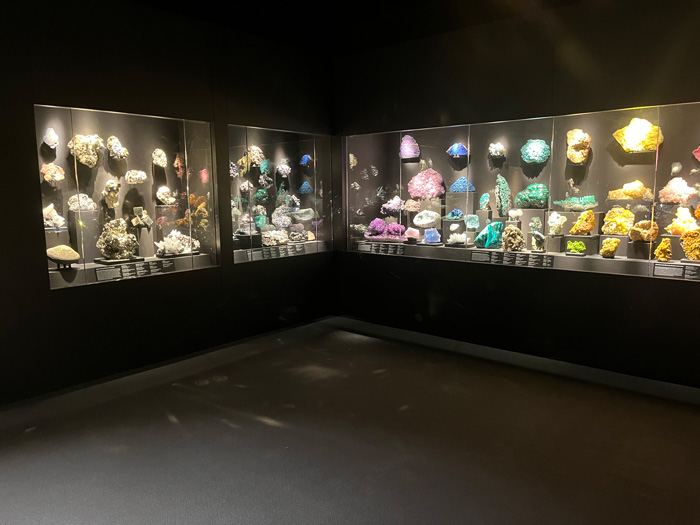
“The Bruce is back,” Daniel Ksepka, Ph.D., curator of science, proclaimed with raised fists at the March 28 preview for the newly renovated and expanded Bruce Museum in Greenwich.
And how.
The museum ”” which opened to the public Palm Sunday, April 2, with a day of free admission, thanks to lead partner Bank of America ”” has created a modern new three-story wing that hugs the traditional existing building ”” more than doubling the Bruce”™s footprint to 74,500 gross square feet. The new 44,000-square-foot wing includes a new entrance, lobby, event spaces, auditorium and café, which features breakfast offerings, soups, salads, sandwiches and beverages from Aux Délices. (The café is across the lobby from the elegant new museum store, always a highlight of any Bruce visit but now with more storage space to replenish all those plush penguins, Frida Kahlo plates, René Magritte and Vincent van Gogh dolls, jeweled insect and flower pins and artistic jackets.)
In its 10-year, $67-million renovation and expansion, the Bruce makes a “CASE” for itself, said Robert Wolterstorff ”” the museum”™s Susan E. Lynch executive director and CEO ”” referring to an acronym for community, art, science and education.
“The Bruce is a museum of the arts and sciences,” he added. “It”™s our superpower”¦.But it”™s not our whole mission. We”™re also an educational institution. It”™s in our DNA.”
Prior to the pandemic, the Bruce saw 25,000 to 26,000 schoolchildren in a year. Wolterstorff said he expected that number to double in the new Steven & Alexandra Cohen Education Wing. But he also spoke about how museums not only belong to and reflect their communities but create them as well with their amenities, public spaces and programming ”” all of which encourage social gatherings as well as cultural communing.

No doubt the triumphant design will have much to do with this. Steve Dumez ”” a principal and director of design with EskewDumezRipple, with offices in New Orleans and Washington, D.C. ”” has created a space that lets the outside in, including gardens by Cambridge, Massachusetts, landscape architect Reed Hilderbrand, rock outcroppings and views of the neighboring Greenwich Harbor and Long Island Sound. At the same time, Dumez has designed a museum extension that is Connecticut to its bones. The gleaming striated façade of precast concrete and glass is inspired by the surfaces of the Nutmeg State”™s stone quarries, he said. Light, airy white oak figures in the floors, galleries and auditorium. Gray Phoenix stone makes up the floor of the white Sculpture Gallery, which bridges the art and science galleries and crystallizes the fusion of inside and outdoors that is the motif of the architectural achievement. Visitors look past Elie Nadelman”™s small female nudes on pedestals to a window that frames nature”™s art ”” a large, spreading tree whose still-naked limbs are about to be clothed by spring; sloping rocks, eternal in their constancy; the bisque-colored, Mediterranean-style Delamar Greenwich Harbor hotel (Page 11); and, in the distance, the Sound itself.
The Nadelman sculptures are a reminder that with more space comes the opportunity to display more artworks and scientific artifacts. The 13,000-square-foot William L. Richter Art Wing includes a 4,500-foot gallery for changing exhibits and five new galleries for the burgeoning permanent collection. A year ago, the Bruce announced it had received a promised gift of 70 works from an anonymous donor, the largest bequest of art in the museum”™s 112-year history. Selections from that collection ”” which include works by Mary Cassatt, Alberto Giacometti, Childe Hassam, Winslow Homer, Edward Hopper, Wassily Kandinsky, Joan Miró, Henry Moore, Camille Pissarro, John Singer Sargent and Andrew Wyeth ”” along with two works on paper by Henri Matisse and Pablo Picasso, a bequest of William L. Richter, the wing”™s namesake, bring to the museum, often for the first time, great names in the canon of art.
Their displays are joined by “Lois Dodd: Natural Order” (through May 28), landscapes and cityscapes that evoke the work of Hopper and Georgia O”™Keeffe in their blend of abstraction and realism; “James Castle: Thresholds” (May 28), in which the self-taught deaf artist, who never learned to speak, read or write, invites us into the world of his rural Idaho home; and “Then is Now: Contemporary Black Art in America” (through July 9), a thought-provoking consideration of the Black experience. Organized by Margarita Karasoulas, curator of art, the shows are threaded by the jewel-like palette ”” marigold, eggplant and crimson ”” of longtime director of exhibitions, Anne von Stuelpnagel.
The jewel-like quality continues as you move from the art wing into the older building and the seven Permanent Science Galleries, a suite of spaces on natural history, and the new Science Changing Exhibit Gallery, which features “Penguins! Past and Present” (through Aug. 6), 60 million years of these remarkably adaptable birds.
In one of the Permanent Science Galleries, minerals shine like gemstones on black velvet. A standing, butterfly-shaped display of amethyst ”” a precious stone in ancient Egypt, science curator Ksepka said, but now classified as semiprecious ”” provides visitors with a photo op designed to let them feel as if they”™re soaring on angel wings.
It is a metaphor perhaps for what the Bruce hopes will be a transformative experience for visitors.
For more, visit brucemuseum.org.




















